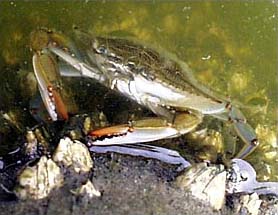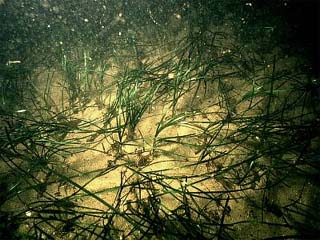|
|
|
|
|
The list of
organisms directly involved in this case have been narrowed to four groups.
Provided for you are some general information about the organisms' eating
habits, size, and other notes. Create a diagram
showing the relationships between the organisms.
|
| INVERTEBRATES |
|
|
Blue
crab
- Callinectes
sapidus
- DIET:
general scavenger, bottom carnivore (eat other animals),
detritivore (eat decaying organic matter), & omnivore
(eat animals or plants); including fish, crustaceans, mollusks,
plants.
- DISTRIBUTION:
Nova Scotia down the east coast of North America, off Bermuda,
throughout the Gulf of Mexico and the Caribbean Sea, and
down the east coast of South America to northern Argentina.
- PREDATORS:
fish, sea jelly, shrimp, planktivores, turtles, sharks,
birds, and even other blue crabs.
- NOTE:
The blue crabs' diet vary depending on their stage
of life.
(www.blue-crab.org/lifecycle1.htm) |

|
|
Shrimp
- Penaeus
aztecus (Brown shrimp), Penaeus setiferus (White
shrimp), and Penaeus duorarum (Pink shrimp)
- DIET:
detritus, i.e. broken pieces of dead plants and animals
- DISTRIBUTION:
Atlantic coast of U.S. to Gulf of Mexico
- PREDATORS:
fish, crabs, human
- NOTE:
second most valuable fishery in NC; by-catch from shrimp
harvest is a cause for concern.
(www.sms.si.edu/irlspec)
|
|
|
|
|
|
| FISH |
|
|
Striped
bass
- Morone
saxatilis
- DIET:
fish, crabs
- DISTRIBUTION:
St. Lawrence River, Canada to St. Johns River, Florida
- PREDATORS:
large fish, humans
- NOTE:
Major predator of juvenile blue crabs; commercially &
recreationally valuable fish in NC.
|
 |
|
|
|
|
| VEGETATION |
|
|
Seagrass
- Zostera
marina (eelgrass), Halodule wrightii (shoalgrass),
and Ruppia maritima (widgeongrass)
- DIET:
make its own food with sunlight and nutrients via photosynthesis
- DISTRIBUTION:
estuarine communities worldwide
- PREDATOR:
herbivores
- NOTE:
Provide a refuge area for many juvenile fish and shellfish.
(www.itsligo.ie/biomar/SUB_SEDS/BIOT0304.HTM) |

|
|
|
|
back
to top
|
| HUMANS |
|
|

|
North
Carolina
- SIZE:
48,711 sq. miles
-
POPULATION: 8,049,313
- CAPITAL:
Raleigh
- PEOPLE:
72.1% Caucasian; 21.6% Black; 4.7% Hispanic; 1.4% Asian;
1.2% Native American
- LANGUAGES:
English
- RELIGION:
Baptist, Christian, Catholic
- MAJOR
INDUSTRIES : agriculture, commercial fishing, mining
(www.50states.com/ncarolin.htm)
|
|
|
|
|
| |
This web
site was created by Lynn Tran at the North Carolina State University, Department
of Mathematics, Science, and Technology Education on 7/12/03. Faculty advisor
Dr. David Eggleston, NCSU, Department of Marine, Earth, & Atmospheric Sciences.
Last updated
December 29, 2003
.
|




